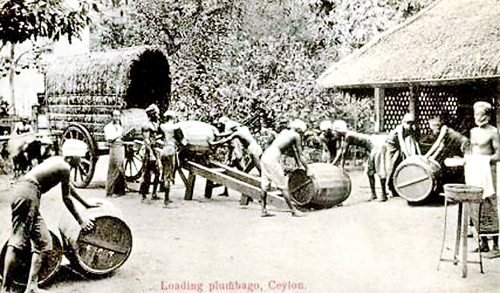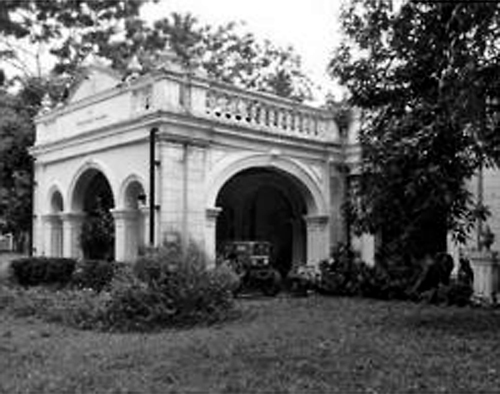Don Spater Senanayake and the Temperance Movement

A picture from the past: Loading plumbago
This country and its people were under foreign powers for more than four centuries. The battle of Mulleriyawa, during the Portuguese era and the Uva Rebellion during the British, were two main uprisings against colonial rule in the country’s long struggle for independence.
Although they were not fully successful mainly due to the social, economic, and environmental factors at that time, the country did achieve its final goal later mainly due to the commitment of a few individuals who worked with greater determination and dedication to continue their struggle.
The Senanayake family of Bothale, Hapitigam Korale, Mirigama figured prominently in the country’s struggle for Independence with Mudaliyar Don Spater Senanayake, who was the head of the family and the main sponsor of the second stage of the Temperance Movement which started in 1912 at its helm. He was the father of F.R.Senanayake, who also rendered valuable service to the Temperance Movement and the promotion of Buddhism and the Buddha Sasana in the country and also of Don. Stephen Senanayake, the first Prime Minister of Independent Sri Lanka (then Ceylon).
The historical journal “Twentieth Century Impressions of Ceylon”- (original) published in 1907, in London and edited by the British author Arnold Wright and H.A.G. Hulugalle’s “The Life and Times of Don Spater Senanayake – Sri Lanka’s First Prime Minister, both confirm Don Spater’s early education at St Thomas’ College, Matale, and entry into the plumbago business at a very early age.

Mudliyar Don Spater Senanayake
According to Wright, Don Spater Senanayake was a very wealthy person with a good education who had started business on his own in the plumbago trade, at the early age of 18. He was one of the largest mine owners in the island and controlled the mines of Ambepussa, which had been worked for 20 years using steam pumping gear of 34 horsepower.
These mines employed about 3000 people. Don Spater, during that time, had also commenced mining operations in parts of Mirigama and Pussehena in the Kegalle District. He also owned more than 2000 acres in the Kurunegala District and other plantations in various parts of the North-Western Province, in addition to a large number of residential properties in Colombo and Kandy.
Arnold Wright further confirms that Don Spater Senanayake was a liberal contributor to charitable causes such as the Victoria Memorial Eye Hospital and the Indian Famine Relief Fund. In recognition of his services Don Spater Senanayake was conferred with the title of Mudaliyar by Governor Sir Joseph H.West Ridgeway.
Jayasena Dahanayake in his book “Deshabandu F.R.Senanayake” introduces F.R.Senanayake as a devout Buddhist, who spent lavishly to promote the Temperance Movement in 1919 upto the time of his death in 1925 after which his elder brother took his place in the movement.
K.M. de Silva, Professor of History at Peradeniya University in his book titled “The Life of D.S.Senanayake (1884 – 1952) -Sri Lanka’s First Prime Minister (1948 -1952) Political Background” describes Don Spater as being a graphite merchant, a planter and wealthy person.
Graphite (or plumbago) was a much sought after raw material which was in great demand by Japan, USA and Europe and was widely referred to as ‘Black Gold’ or “kalu ran’.
K.M.de Silva further states Don Spater Senanayake also held the prestigious position of Chairman, of the Graphite Manufacturers Association.
He was wealthy enough to provide his second son, Fredrick Richard (F.R.) the best available education in England at Cambridge University and at the Middle Temple Inns of Court in London, from which he graduated as a barrister.
From all records , it is evident that with the wealth and resources available to Don Spater Senanayake, the necessity to get involved in the arrack rental business did not arise.
However in Dr. Kumari Jayawardena’s book, “Nobodies to Somebodies: The Rise of the Colonial Bourgeoisie in Sri Lanka” and its Sinhala translation “Sokkan Lokkan Wu hati” , the author states that Don Spater Senanayake had been involved in trading in Arrack “as arrack renter” and had used the profits so generated to help in the Temperance Movement.
After the demise of Don Spater, the management of the Botale Mining Complex and sorting and processing, prior to export, were taken over by his sons Don Charles and Don Stephen Senanayake, the first Prime Minister of Sri Lanka.
The two main reasons for locating the Railway Station of the Colombo – Upcountry line in 1865 at Ambepussa, was firstly, due to its close proximity to the Ambepussa Rest House, its easy access by horse- carriage and secondly because of its closeness to the graphite mining complex of Don Spater Senanayake, which was located at Bothale. The graphite extracted from mines had to be transported to Colombo (Kitulwatte Stores) by rail and road for further processing.
His nephew Devinda S. Senanayake is still in possession of the Mining Licences A 508, A509, A 510, and A 583, issued to Don Spater Senanayake and Don Stephen Senanayake, to work these mines. During this period, the users of some roads were required to pay a toll to the authorities. Since the administrative district where the mines were located was Negombo, it became necessary to frequently travel between Mirigama and Negombo for various matters connected with the administration of the mines and between Mirigama and Colombo for matters connected with the export of graphite. Don Spater Senanayake had to pay a toll to use them.
He also made use of these roads to move his labour force to and from the properties he owned and permitted other miners too to use them to transport their produce, so that they could also fetch better prices.
Don Spater Senanayake had taken a lease on these roads: Negombo – Giriulla and Giriulla – Pasyala and paid the lease rentals. The original Lease Deeds No 5366, 5393 issued for 1897 dated December 2, 1896 had been given to Devinda Senanayake by Ven. Delwala Sri Munindobhasa Thera of the Senanayake Mudalindaramaya,Temple, Pirisyala, and are still well preserved.
At a time when the establishment of taverns and sale of toddy was encouraged and promoted by the Colonial Government, the Temperance Movement sought to discourage it by educating the public of the evils of consuming alcohol, presumably to prevent the people from becoming addicted .
Addiction to alcohol had been the main reason behind the irrational behaviour of the last King of Kandy Sri Wickrema Rajasinghe, which finally resulted in the country falling to the foreign powers. The route that was taken to take John D’Oyly inland to Hath Korale, on January 13,1815 is given in the “Twentieth Century Impressions of Ceylon” and the manner in which the King became addicted to alcohol is explained in the publications, “John D’Oyly’s Diaries” and “Wadu-gaha hatana”.

The Senanayake family home: Bothale walauwa
Prof. N. Dharmaratna, of the Department of History and Archaeology of the Sri Jayawardenapura University confirms the availability of these two documents in the Colombo Museum and the Library of the National Achieves.
The adverse effects alcohol has had on some other races may have been another reason that prompted these freedom fighters to discourage the use of alcohol.
During the Colonial era, the word “Arrack renter” was used to describe a person authorized to operate taverns and/or to collect taxes. This word has crept into the Sinhala vocabulary as “Arakku Rendha”.
This position is further explained by Prof. K.M. De Silva in his book “DS- the life of D.S. Senanayake 1884 -1952, – thus during this period a person collecting taxes, on behalf of the government from the owners of arrack taverns, was called “Arrack Renter” in English and the same is used in Sinhala but pronounced differently (Rendha).
Since the issue of licences generates an additional source of income for the Government it would have most certainly been recorded by the authorities, if such licences / permission had in fact been issued, in the register maintained for that purpose. Perusing the certified copies of the relevant page of the register, provided by the National Archives , it is evident from the entries therein that a licence/permission had , in fact been granted , to operate a tavern during the period, 1894 and 1895., to another wealthy family by the same surname, but with different initials and of a different address who lived in the Negombo District, in the Aluthkooru korale, Dunagaha, Madampe.
This coastal area was well known for the production of toddy, distilling arrack and for making wooden storage casks.
Since the issue of licences for operating/sale of alcohol generate additional income for the authorities, if a licence/permit had been issued to Mudaliyar Don Spater Senanayake, such information would most certainly have been recorded in this register and would not have escaped the attention of an investigative writer such as Wright.
A house and a property which belonged to Don Spater was donated to the Buddha Sasana, on the 19th June 1911, to mark the birth of his grandson, Dudley Shelton Senanayake who was to later become a popular and much loved Prime Minister of Sri Lanka. This temple is now known as the Senanayake Mudalindarama Pirivena.
It should be the responsibility of educated individuals, when describing those who were in the forefront of gaining our independence, by spending their wealth, time and also risking their lives, to be more careful in making unfounded statements about them.
(The writer is Media Secretary of the Senanayake Foundation)


